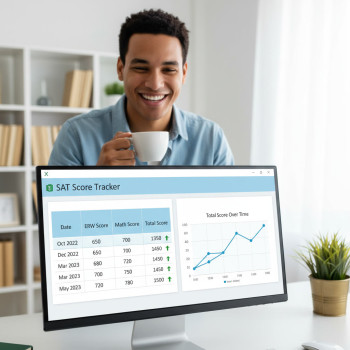Why the Digital SAT Is a Skill—and Why That Changes Everything
Imagine you’re learning to play guitar. You don’t memorize a chord chart and hope it magically turns into a concert— you practice chords, build finger strength, learn patterns, and play real songs. The Digital SAT works the same way. It’s not just an inventory of vocabulary words or math formulas to store in your head; it’s a set of cognitive skills you develop: problem recognition, time management, logical reasoning, pattern spotting, and clear written expression.
That shift—from content-focused cramming to skill-focused training—changes how you study, how you measure progress, and how you feel on test day. The Digital SAT’s format, shorter adaptive sections, and onscreen tools reward habits and judgment as much as raw knowledge. Students who treat it as a skill get better scores with less late-night panic and more consistent, sustainable progress.
What It Means to Treat the SAT as a Skill
Treating the SAT as a skill means three things in practice: practice deliberately, learn strategies that transfer, and reflect on performance. It’s a cycle: try, analyze, adjust, repeat. Instead of asking “What vocabulary should I memorize?” you ask “Which reading strategies help me find evidence faster?” Instead of “Which formulas do I need?” you ask “How do I quickly identify the structure of a problem and the most efficient method to solve it?”
Deliberate Practice Beats Passive Review
Deliberate practice is focused, time-limited, and aimed at specific weaknesses. Instead of reading through a chapter of algebra and hoping your speed improves, practice these precisely:
- Timed sections of problem-solving with a single tactical focus (e.g., manipulation of algebraic fractions).
- Paragraphs of dense reading where your only goal is to annotate the main claim and two supporting ideas within a strict time limit.
- Writing 15-minute essays to refine thesis clarity and evidence use, then receiving targeted feedback.
These focused drills build the micro-skills the test demands: spotting the core idea, eliminating wrong answer traps, and structuring a fast, clear response.
Strategy Over Memorization
Skills are strategies you can use in many questions. For example, a single reading strategy—previewing questions to guide your read—works across passages. A problem-structure strategy—identifying what type of algebraic setup applies—reduces the time you spend guessing which formula to use.
Strategies you can practice include:
- Active reading: annotate purposefully, not obsessively.
- Answer elimination: practice discarding two answers quickly to increase odds.
- Backsolving and plugging in numbers for tricky algebra problems.
- Using the Digital SAT tools: highlighting, line references, and the built-in calculator when it helps—practice makes them intuitive.
How the Digital Format Rewards Skill-Building
The Digital SAT is adaptive and delivered on devices via the Bluebook testing app. That means the test responds to your performance, and a single error can affect the difficulty of subsequent questions. Rather than being punished for not knowing a fact, you’re tested on how well you apply reasoning under time and format constraints. This rewards skillful, consistent approaches more than last-minute facts.
Time Management and the Adaptive Engine
Because the test adapts, time mismanagement can cost more than one wrong answer. Skill-building trains you to allocate time where it counts—recognize when to move on, when to guess, and when to invest extra minutes. Practice sessions that simulate adaptive timing are crucial; they teach you to maintain composure when a question seems tough rather than getting bogged down.
Practical Steps to Train Your SAT Skills
Below is a study framework—think of it as a training program, not a syllabus. It’s built around repeated cycles of focused practice, reflection, and intentional improvement.
Weekly Training Plan (Sample)
This plan assumes about 8–10 hours per week of focused preparation, scalable up or down.
- 2 hours: Full-section timed practice (alternate Reading, Writing & Language, Math) using digital practice tests.
- 2 hours: Targeted skill drills (e.g., sentence structure, algebra manipulations, data interpretation).
- 2 hours: Mistake analysis—review every incorrect and guessed question and build a correction checklist.
- 1 hour: Strategy work—time management, question triage, and calculator usage drills.
- 1–2 hours: Reading for depth—editorials, science articles, and humanities passages with active annotation.
Daily Micro-Practices
- 15 minutes of vocabulary-in-context practice (not rote definitions—application in sentences).
- 20 minutes of number sense: mental math tricks, estimation, and common algebraic manipulations.
- 10 minutes of reflection: what went well? what will I do differently tomorrow?
How to Analyze Mistakes Like a Pro
Mistake analysis is where training becomes smarter. Instead of simply marking a question wrong, break it down:
- Identify the error type: conceptual mistake, careless error, time pressure, misread question.
- Record the specific cause: weak algebraic rearrangement, failure to note negation in a sentence, misread figure, or mis-click on the device.
- Create an action step: a 10-minute drill to fix that exact issue next practice session.
Over time, your error-log becomes the roadmap for efficient improvement. Look back every two weeks and measure how many times the same error type repeats; that number should drop steadily.
Examples: Skill vs. Content Approaches
Here are two short examples showing how a skill-oriented approach beats content-only study.
Reading Passage Example
Content approach: memorize more literary terms and hope the questions align.
Skill approach: practice identifying the author’s thesis in 20 seconds, underline signal phrases, and map paragraph function (claim, evidence, example). With time, you’ll pull correct evidence faster—regardless of the passage’s topic.
Math Problem Example
Content approach: memorize formulas and lists of problem types.
Skill approach: learn to recognize common structures (rate, proportion, quadratic, linear) and apply problem-solving patterns like backsolving, picking numbers, or simplifying before you compute. These strategies often cut solution time dramatically.
Measuring Progress: The Right Metrics
Progress isn’t just raw score increases. Use layered metrics:
- Accuracy on targeted problem types (e.g., algebraic fractions).
- Average time per question by section.
- Error-type frequency from your mistake log.
- Full-practice test score trends, but only as one signal among many.
Track these metrics weekly. Improvement in skill indicators (fewer careless errors, lower time per question, improved accuracy in a problem type) predicts score gains even before a full-test score jumps.
Study Tools That Build Skill
Some tools are just digital flashcards; others train transferable skills. Prioritize resources that let you practice under conditions like test day: timed, adaptive, and with the same interface.
| Tool Type | How It Builds Skill | Practice Recommendation |
|---|---|---|
| Full-length digital practice tests (Bluebook) | Mimics test interface and timing; builds endurance and strategy under adaptive conditions | Take 1 test every 2–3 weeks; review thoroughly |
| Targeted drills (timed sections) | Improves accuracy and speed on one skill at a time | Daily 20–40 minute sessions |
| Annotated reading practice | Teaches quick evidence-finding and main-idea extraction | 3 passages per session, with focused annotations |
| 1-on-1 tutoring / personalized plans | Targets specific weaknesses; provides feedback loop and accountability | Weekly sessions with homework aligned to your mistake log |
The Role of Coaching: When Personalized Help Supercharges Skill-Building
There’s a big difference between studying harder and studying smarter. A good tutor or coach observes patterns you can’t see in yourself—recurring habits that cause careless errors or poor pacing choices. Sparkl’s personalized tutoring, for example, blends 1-on-1 guidance, tailored study plans, expert tutors, and AI-driven insights to help students train the right skills faster. When coaching fits naturally into your plan, two things happen: you compress months of independent trial-and-error into weeks, and you build confidence that sticks.
What Effective Tutoring Adds
- Accountability and structure so practice happens consistently.
- Targeted drills created from your mistake log.
- Real-time feedback on strategy—what to do next practice session.
Practice-Test Strategy: It’s Not Just About Scores
Full practice tests are diagnostic tools, training runs, and confidence builders. But if you only take them to watch the score tick up and down, you’re missing the point. Use practice tests to:
- Practice test-day routines: device setup, breaks, and timing rhythm.
- Harvest hard data: what question types slow you down, and why.
- Simulate stress management: learn how you react when you miss a question and how to recover mentally.
After every full test, spend at least double the test time reviewing mistakes. That’s where the real improvement happens.
The Mindset Shift: Growth Over Performance
Treating the SAT as a skill invites a growth mindset. Instead of seeing a low score as failure, see it as information. Every wrong answer tells you what to train next. This mindset reduces anxiety because the focus is on learning and progress rather than being judged by a single number.
Practical Mindset Tips
- Set process goals (e.g., “I will review every mistake and build a drill for it”) rather than outcome goals alone.
- Celebrate small wins: faster time on a question type, fewer careless errors in a week.
- Use practice tests to practice emotional regulation: breathe, reset, move forward.
Common Pitfalls When Students Treat the SAT as Content
Here are a few classic mistakes to avoid:
- Relying on endless vocabulary lists without practicing context usage.
- Memorizing formulas without practicing when and how to use them efficiently.
- Taking too many untimed practice questions that don’t simulate real conditions.
- Ignoring the interface and navigation quirks of the Bluebook app.
Instead, turn each of these pitfalls into a training target: context-driven vocabulary drills, timed formula application, adaptive practice sessions, and simulation of the digital environment.
Putting It All Together: A 12-Week Skill-Building Roadmap
This roadmap is a condensed guide for students starting 12 weeks from test day. It’s flexible; adjust intensity based on how many hours per week you can commit.
- Weeks 1–4: Baseline and fundamentals. Take a full digital practice test. Build a mistake log. Start daily micro-practices and two focused skill drills per week.
- Weeks 5–8: Skill consolidation. Continue drills, begin timed full sections twice weekly, and take one full practice test at the end of week 8. Consider weekly tutoring sessions for targeted feedback (Sparkl’s personalized tutoring can be particularly effective here for creating a tailored plan).
- Weeks 9–11: Sharpening and simulation. Ramp up simulated test conditions: device setup, breaks, strict timing. Focus on pacing and error reduction. Use your mistake log to eliminate recurring error types.
- Week 12: Taper and mindset. Reduce study volume, focus on light drills and mental preparation, and finalize test-day logistics.
Small Habits That Make a Big Difference
Beyond drills and tests, small consistent habits compound fast:
- Read one thoughtful article every day and summarize it in two sentences.
- Keep a one-page “mistake checklist” you review before every practice session.
- Practice three deep-breath resets so you can recover when you hit a hard question on test day.

Final Thoughts: You’re Learning a Transferable Skill
When you train the SAT as a skill, you gain more than a potential score increase. You build metacognition—the ability to think about how you think—which helps in college classes, career problem solving, and lifelong learning. The strategies you practice—clear reading, structured problem solving, time management, and thoughtful review—become tools you’ll use long after test day.
If you want to accelerate that process, personalized tutoring that stitches together 1-on-1 guidance, tailored study plans, expert coaching, and AI-driven insights can cut wasted effort and speed up skill acquisition. When tutoring is used to target the exact habits revealed by your practice tests, it moves you from repeating mistakes to mastering techniques.
Takeaway Checklist: Start Training Today
- Stop cramming content lists—begin focused skill drills instead.
- Keep a detailed mistake log and review it weekly.
- Take full digital practice tests under realistic conditions every 2–3 weeks.
- Practice pacing and recovery strategies to handle difficult adaptive sequences.
- Consider targeted 1-on-1 tutoring for accountability and efficient correction of persistent errors.
Think of the Digital SAT as a skill you develop. Practice the right moves, measure the right things, and treat mistakes as data, not defeat. If you do that, you’ll not only improve your test scores—you’ll gain habits that make school and life easier. Start small, be consistent, and train smart.













No Comments
Leave a comment Cancel